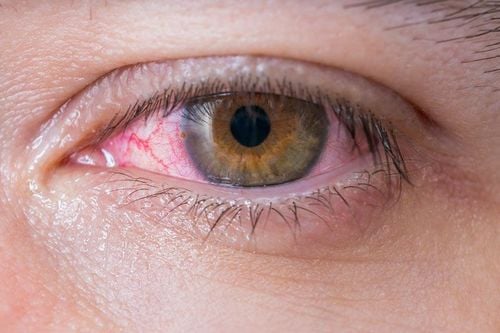Cravit is an antibiotic of the quinolone group, with the active ingredient Levofloxacin, formulated as an eye drop solution. Cravit is used to treat bacterial eye infections. Follow the article below to learn detailed information about Cravit.
1. What is Cravit?
Cravit contains the main ingredient Levofloxacin at a concentration of 5%, formulated as an eye drop solution, packaged in a box with 1 bottle of 5 ml.
Mechanism of action of Cravit:
- Levofloxacin is an antibiotic that inhibits bacterial DNA synthesis by inhibiting the activity of DNA gyrase topoisomerase II and topoisomerase IV.
- Levofloxacin has strong antibacterial properties, with a broad in vitro spectrum against gram-positive bacteria, gram-negative bacteria, and anaerobic bacteria.
2. What conditions does Cravit treat?
Cravit is used to treat eye infections such as:
- Blepharitis, conjunctivitis.
- Dacryocystitis, tarsal conjunctivitis.
- Chalazion (stye), keratitis, corneal ulcers.
- Prevention of infections before and after eye surgery.
3. Dosage and administration of Cravit
Dosage:
- The usual dose of Cravit for both adults and children is 1 drop per time, 3 times a day.
- The dosage of Cravit can be adjusted according to the condition.
- The duration of Cravit use depends on the type of infection and the patient's response.
Administration:
- Read the instructions for the use of Cravit carefully before use.
- Cravit is used as an eye drop.
- When using eye drops, do not let the tip of the Cravit bottle touch the eye to avoid contamination and potential eye injury.
Note: When using more than one eye drop medication, administer them at least 5 minutes apart.
4. Contraindications of Cravit
Do not use Cravit for individuals who:
- Are hypersensitive to levofloxacin or any other ingredients in the formulation.
- Are allergic to ofloxacin or any other antibiotics in the quinolone group.
5. Side effects of Cravit
Unwanted side effects in the eyes:
- Corneal damage, superficial diffuse keratitis, burning eye pain.
- Blepharitis, red eyes.
- Eye irritation, reduced vision.
Systemic unwanted side effects:
- Anaphylactic reactions, shock.
- Red rash, hives, low blood pressure, difficulty breathing, eyelid swelling, headache, fainting, seizures.
6. Precautions when using Cravit
- Only use Cravit for bacteria sensitive to the medication to avoid the development of resistance.
- Use Cravit at the prescribed dosage and duration, even if symptoms have resolved.
- For patients with MRSA infections who do not see symptom improvement with Cravit, switch to another effective MRSA antibiotic immediately.
- Cravit is prescribed by a doctor.
- There have been no reports of Cravit's effects on individuals requiring high concentration, such as drivers or machine operators.
- Use Cravit for pregnant women only if the treatment benefits outweigh the potential risks. There are no safety reports for Cravit in this case.
- For breastfeeding mothers, Levofloxacin is excreted in breast milk. However, the therapeutic dose of the medication is reported not to affect the child. Use with caution in this case.
- Storage: Keep Cravit in a dry place at a temperature below 30°C, away from direct light, moisture, the freezer, or near heaters.
7. Drug interactions
There have been no reports of Cravit interactions when used with other drugs.
Provide your doctor with complete information about all medications you are taking for the most appropriate use.
Cravit is an antibiotic used to treat bacterial eye infections. The product is available at Vinmec pharmacies. To use Cravit safely and effectively, follow your doctor's advice. If you have any questions about Cravit, contact your doctor immediately.
To arrange an appointment, please call HOTLINE or make your reservation directly HERE. You may also download the MyVinmec app to schedule appointments faster and manage your reservations more conveniently.











